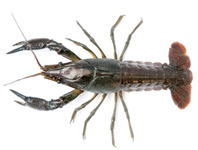Abstract
A new species of Coelioxoides Cresson (Apidae), Coelioxoides piscicauda sp. nov. Rocha-Filho from São Paulo State, Brazil, is described. A key to the four recognized species of the genus, C. exulans (Holmberg), C. piscicauda sp. nov., C. punctipennis Cresson, and C. waltheriae Ducke, is provided. In addition, new host records of Coelioxoides are presented as well as a compilation of published data on species of Tetrapedia Klug associated with this cleptoparasitic genus.
References
Aguiar, C.M.L., Garófalo, C.A. & Almeida, G.F. (2005) Trap-nesting bees (Hymenoptera, Apoidea) in areas of dry semideciduous forest and caatinga, Bahia, Brazil. Revista Brasileira de Zoologia, 22, 1030–1038.
https://doi.org/10.1590/S0101-81752005000400031Alves-dos-Santos, I. (2003) Trap-nesting bees and wasps on the University Campus in São Paulo, Southeastern Brazil (Hymenoptera: Aculeata). Journal of the Kansas Entomological Society, 76, 328–334.
Alves-dos-Santos, I., Melo, G.A.R. & Rozen, J.G. (2002) Biology and immature stages of the bee tribe Tetrapediini (Hymenoptera: Apidae). American Museum Novitates, 3377, 1–45.
https://doi.org/10.1206/0003-0082(2002)377%3C0001:BAISOT%3E2.0.CO;2Araújo, P.C.S., Lourenço, A.P. & Raw, A. (2016) Trap-nesting bees in Montane Grassland (Campo Rupestre) and Cerrado in Brazil: collecting generalist or specialist nesters. Neotropical Entomology, 45, 482–489.
https://doi.org/10.1007/s13744-016-0395-9
Ascher, J.S. & Pickering, J. (2017) Discover Life bee species guide and world checklist (Hymenoptera: Apoidea: Anthophila). Available from: http://www.discoverlife.org/mp/20q? guide=Apoidea_species (accessed 3 August 2017).
Bertoni, A.W. (1911) Contribución á la biología de las avispas y abejas del Paraguay (Hymenoptera). Anales del Museo Nacional de Historia Natural de Buenos Aires, 15, 97–146.
Camillo, E. (2005) Nesting biology of four Tetrapedia species in trap-nests (Hymenoptera: Apidae: Tetrapediini). Revista de Biología Tropical, 53, 175–186.
Camillo, E., Garófalo, C.A., Serrano, J.C. & Muccillo, G. (1995) Diversidade e abundância sazonal de abelhas e vespas solitárias em ninhos armadilhas (Hymenoptera, Apocrita, Aculeata). Revista Brasileira de Entomologia, 39, 459–470.
Cardinal, S., Straka, J. & Danforth, B.N. (2010) Comprehensive phylogeny of apid bees reveals the evolutionary origins and antiquity of cleptoparasitism. PNAS, 107, 16207–16211.
https://doi.org/10.1073/pnas.1006299107
Cordeiro, G.D., Taniguchi, M., Flechtmann, C.H.W. & Alves-dos-Santos, I. (2011) Phoretic mites (Acari: Chaetodactylidae) associated with the solitary bee Tetrapedia diversipes (Apidae: Tetrapediini). Apidologie, 42, 128–139.
https://doi.org/10.1051/apido/2010044Cresson, E.T. (1878) Descriptions of new North American Hymenoptera in the collection of the American Entomological Society. Transactions of the American Entomological Society, 7, 61–136.
Ducke, A. (1908) Contribution à la connaissance de la faune hyménoptérologique du Nord-Est du Brésil. Revue D'Entomologie, 27, 57–87.
Garófalo, C.A. (2008) Abelhas (Hymenoptera, Apoidea) nidificando em ninhos-armadilha na Estação Ecológica dos Caetetus, Gália, SP. Anais do VIII Encontro sobre Abelhas - Biodiversidade e uso sustentado de abelhas, 8, 208–217.
Gazola, A.L. & Garófalo, C.A. (2009) Trap-nesting bees (Hymenoptera: Apoidea) in forest fragments of the State of São Paulo, Brazil. Genetics and Molecular Research, 8, 607–622.
https://doi.org/10.1590/S0101-81752005000400031
Holmberg, E.L. (1887) Sobre ápidos nómadas de la República Argentina. Anales de la Sociedad Científica Argentina, 23, 17–33.
Klimov, P.B. & O’Connor, B.M. (2007) Ancestral area analysis of chaetodactylid mites (Acari: Chaetodactylidae), with description of new early derivative genus and six new species from the Neotropics. Annals of the Entomological Society of America, 100, 810–829.
https://doi.org/10.1603/0013-8746(2007)100[810:AAAOCM]2.0.CO;2
Klimov, P.B. & O’Connor, B.M. (2008) Morphology, evolution, and host associations of bee-associated mites of the family Chaetodactylidae (Acari: Astigmata), with a monographic revision of North American taxa. Miscellaneous Publications Museum of Zoology University of Michigan, 199, 1–243.
Martins, A.C., Melo, G.A.R. & Renner, S.S. (2014) The corbiculate bees arose from New World oil-collecting bees: implications for the origin of pollen baskets. Molecular Phylogenetics and Evolution, 80, 88–94.
https://doi.org/10.1016/j.ympev.2014.07.003
Mesquita, T.M.S. & Augusto, S.C. (2011) Diversity of trap-nesting bees and their natural enemies in the Brazilian savanna. Tropical Zoology, 24, 127–144.
Michener, C.D. (2007) Bees of the World. 2nd Edition. Johns Hopkins University Press, Baltimore, 953 pp.
Michener, C.D. & Lange, R.B. (1958) Observations on the ethology of Neotropical anthophorine bees (Hymenoptera: Apoidea). The University of Kansas Science Bulletin, 39, 69–96.
Moure, J.S. (2012) Tetrapediini Michener & Moure, 1957. In: Moure, J.S., Urban, D. & Melo, G.A.R. (Orgs.), Catalogue of Bees (Hymenoptera, Apoidea) in the Neotropical Region - online version. Available from: http://www.moure.cria.org.br/catalogue (accessed 3 August 2017)
Pedro, S.R.M. & Camargo, J.M.F. (1999) Apoidea Apiformes. In: Brandão, C.R.F. & Cancello, E.M. (Eds.), Biodiversidade do Estado de São Paulo, Brasil: síntese do conhecimento ao final do século XX: Invertebrados terrestres. Vol. 5. FAPESP, São Paulo, pp.193–211.
Rocha-Filho, L.C. & Garófalo, C.A. (2015) Natural history of Tetrapedia diversipes (Hymenoptera: Apidae) in an Atlantic semideciduous forest remnant surrounded by coffee crops, Coffea arabica (Rubiaceae). Annals of the Entomological Society of America, 109, 183–197.
https://doi.org/10.1093/aesa/sav153
Roig-Alsina, A. (1990) Coelioxoides Cresson, a parasitic genus of Tetrapediini (Hymenoptera: Apoidea). Journal of the Kansas Entomological Society, 63, 279–287.
Roig-Alsina, A. & Michener, C.D. (1993) Studies of the phylogeny and classification of long-tongued bees (Hymenoptera: Apoidea). The University of Kansas Science Bulletin, 55, 124–162.
Straka, J. & Bogusch, P. (2007) Phylogeny of the bees of the family Apidae based on larval characters with focus on the origins of cleptoparasitism (Hymenoptera: Apiformes). Systematic Entomology, 32, 700–711.
https://doi.org/10.1111/j.1365-3113.2007.00394.x

